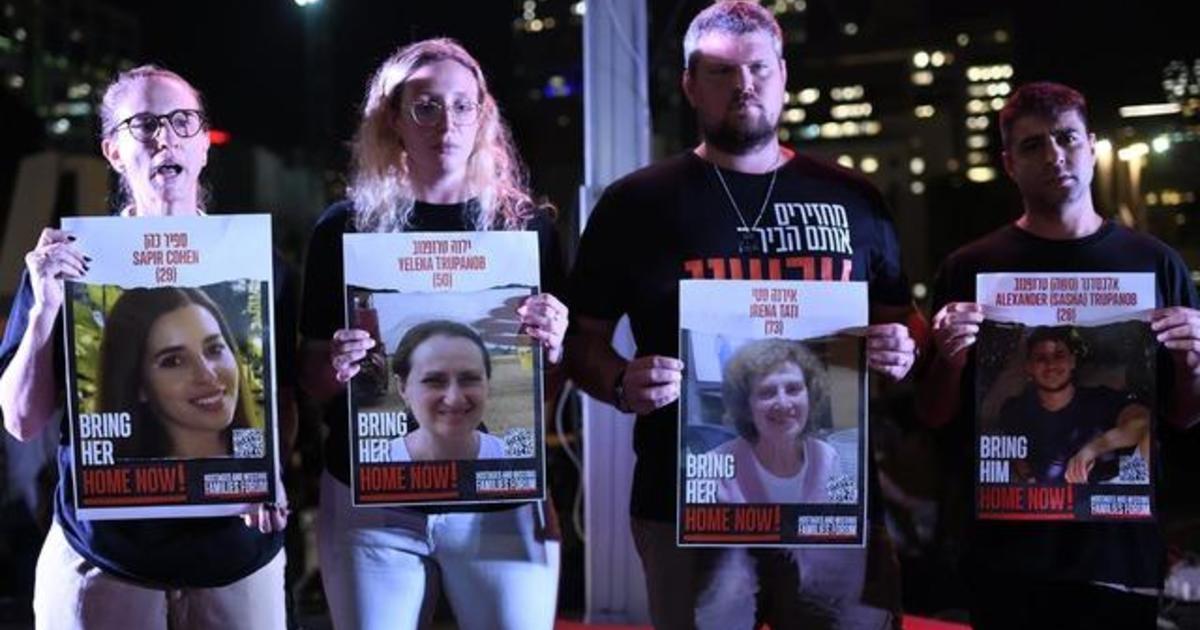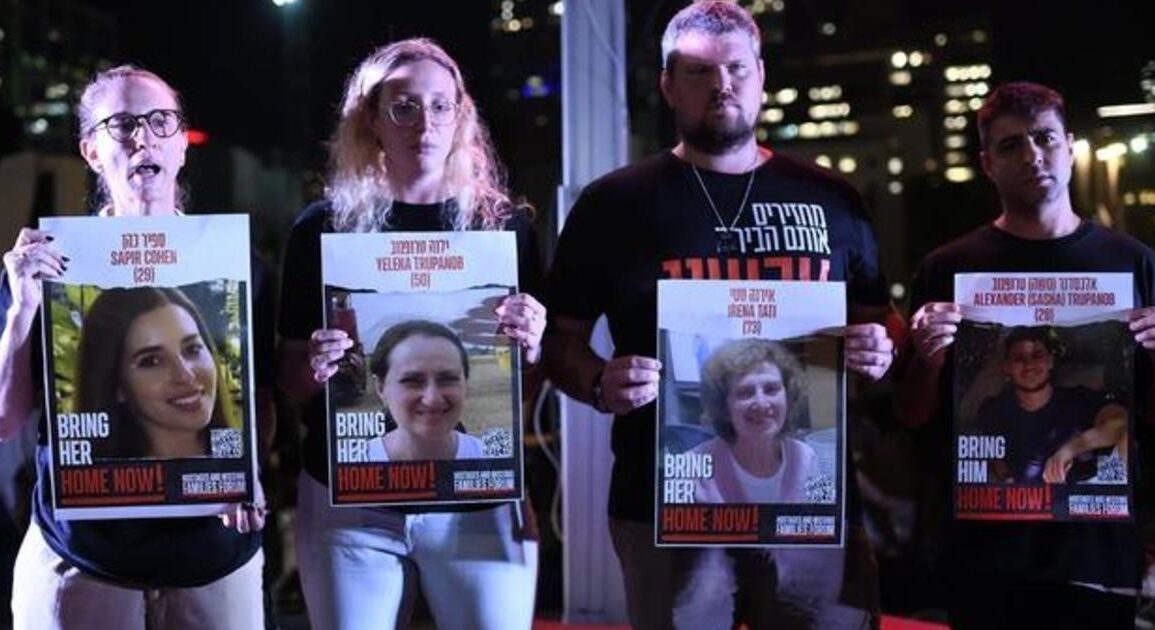
Washington — Israel is considering a proposal that would see Hamas release a portion of the hostages the Palestinian militant group is holding in the Gaza Strip in exchange for a three-to-five-day cease-fire in the war, CBS News has learned. Aid would also be permitted into Gaza during a cessation of hostilities. Under the proposed deal, Hamas would release an unknown number of women and children, two officials with knowledge of the negotiations said.
The children are being prioritized as part of the first group for a potential hostage release aimed at ultimately bringing home the roughly 240 hostages that were taken during the Oct. 7 attack on Israel by Hamas militants.
President Biden said Wednesday that the U.S. believed there were “somewhere between 50 and 100 hostages” in Gaza. So far, only four of the captives, two Americans and two Israelis, have been released by Hamas. During those releases, short-term, targeted pauses in the fighting helped ensure safe transfers of the hostages back to Israel.
As part of the proposal, an unspecified number of Palestinian women and children currently held in Israeli prisons could also be released, one of the officials told CBS News.
It remained unclear where those Palestinian prisoners would go if they were released, according to an official in the region, given that the war in Gaza has displaced nearly 1.6 million Palestinians from their homes, according to figures from the United Nations.
A second official emphasized that only if there was a final deal, this particular long-standing Hamas demand, for Palestinian prisoners to be released, would be part of it. It was unclear how many Palestinian prisoners could be involved. According to Israeli human rights group B’Tselem, there were 147 Palestinian minors in Israeli detention or prison as of June of this year. Palestinian NGO Addameer has a tally of 200 Palestinian children and 62 women imprisoned by Israel as of Nov. 6.
There was nearly a deal at the end of October for a hostage release, but it was scuttled at 11th hour, as CBS News reported.
The politically-charged negotiations have gone through various permutations in recent weeks, and they stalled significantly around the time that Israel launched its ground invasion of Gaza. One constant has been the prioritization of civilians — about 50 of them in particular — over the Israeli military service members who are also being held hostage, according to a source familiar with the negotiations.
Recent weeks have brought a flurry of activity, including CIA Director Bill Burns meeting the head of Israel’s Mossad intelligence agency, along with top Qatari officials, in Doha. That was followed this week by meetings in the region involving President Biden’s top Mideast advisor, Brett McGurk. Qatar, where Hamas has long had an international office, is mediating negotiations with the group.
Among the hostages, there are 10 unaccounted for Americans, according to the State Department. In a disclosure meant to add pressure to the process, the White House revealed this weekend that a 3-year-old girl, a U.S. citizen, was among those believed to be held in Gaza.
One complication in these final stages of the talks has been Hamas’ inability to account for each of the hostages it is either believed to be holding or able to find. Israel is stipulating that that accounting be part of the process. Other militant groups in Gaza may be holding some of the captives. Israel’s demand for a full accounting of the hostages has been complicated by the fact that the captives are spread out across the war zone and are being held by various groups.
“I cannot look you in the eye and tell you that they are still alive,” U.S. National Security Adviser Jake Sullivan said of the American hostages earlier this week.
The U.S. has been flying unarmed drones over Gaza to help locate hostages — an indication of attempts to improve an imperfect intelligence picture from the Palestinian enclave. Last week, Israel revised its number of those killed in the attack as it continues to identify remains, and it remains unsure exactly how many people are still being held captive.
In an earlier proposal, Hamas had said it would be willing to release 10 children as part of a first tranche in exchange for a cease-fire, but Israel demanded more. Throughout the process, there has been a focus on roughly 50 civilians, and an interest among many foreign governments in retrieving dual nationals.
In recent weeks, there have been multiple leaked versions of the proposals, but with no exact figures officially acknowledged by all of the respective governments or Hamas.
Hostage diplomacy is always complicated, but U.S., Israeli and Qatari officials all acknowledge that this is particularly thorny given that the negotiations have been taking place during an active war. Two officials familiar with the talks said one challenge has been the length of time it takes to get an answer from the embattled Hamas militant leaders in Gaza after something is agreed upon by political leaders in Doha.
In recent weeks, Biden administration officials have touted the four hostages already released, including an American mother and daughter, as a test case for future releases. In both previous releases, Qatar served as mediator and the International Committee of the Red Cross was the neutral entity that escorted the hostages from Hamas custody in Gaza to Israeli custody.
In the weeks since those initial releases, however, the hostage issue has become increasingly politically-charged in Israel. Regular demonstrations have seen Israelis vent anger at Israel’s leadership not only for failing to secure the release of the hostages, but for failing to detect and thwart Hamas’ Oct. 7 terror attack in the first place.
As for the broader conflict with Hamas, Israeli officials have indicated to the U.S. that clearing out Hamas militants from in and around Gaza City’s sprawling Al Shifa hospital is one of their primary goals before ending the full-scale war. Another goal is eliminating Hamas commander Yahya Sinwar, believed to be the architect of the Oct. 7 attack. He was a prisoner himself for decades in Israel before being freed as part of a controversial 2011 prisoner swap for the release of Israeli soldier Gilad Shalit.
Speaking Wednesday in Northern California after his meeting with Chinese President Xi Jinping, Mr. Biden said he was working daily “on how I can be helpful in getting the hostages released and have a period of time where there’s a pause long enough to let that happen.”
He said he was doing everything he could to ensure their safe return, but made it clear that did not mean the U.S. was considering sending in its own military forces.
“I am mildly hopeful, I’m mildly hopeful,” Mr. Biden said.
This post was originally published on this site be sure to check out more of their content.







